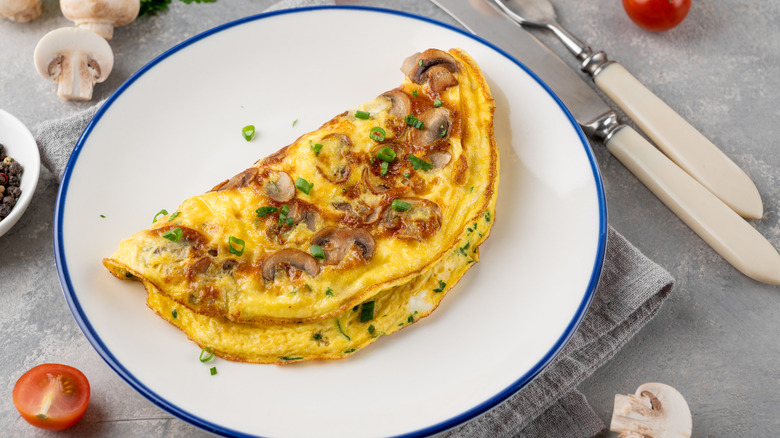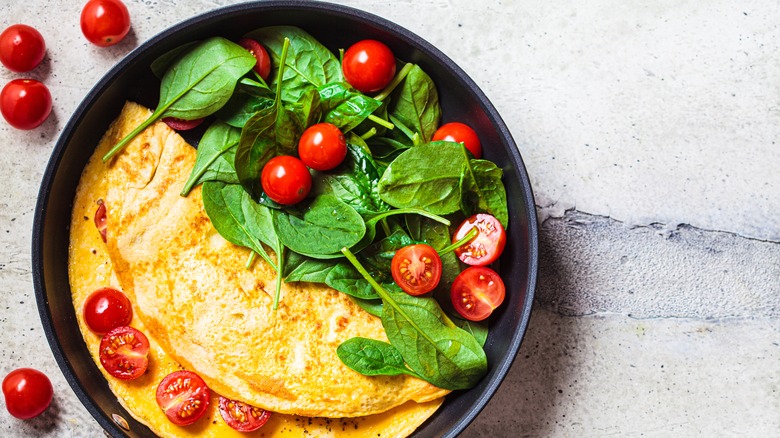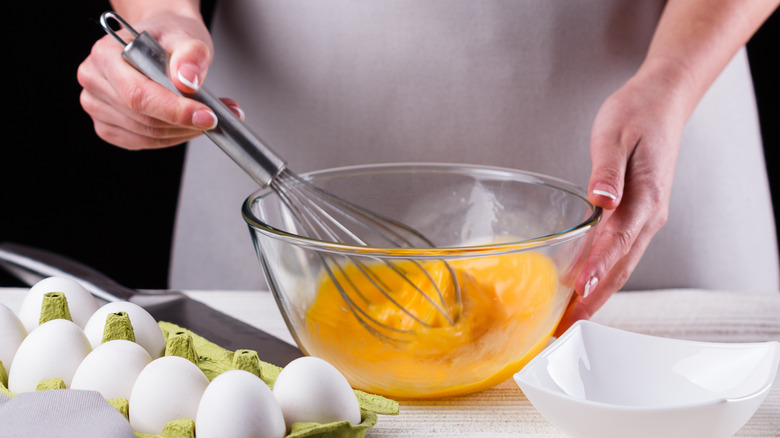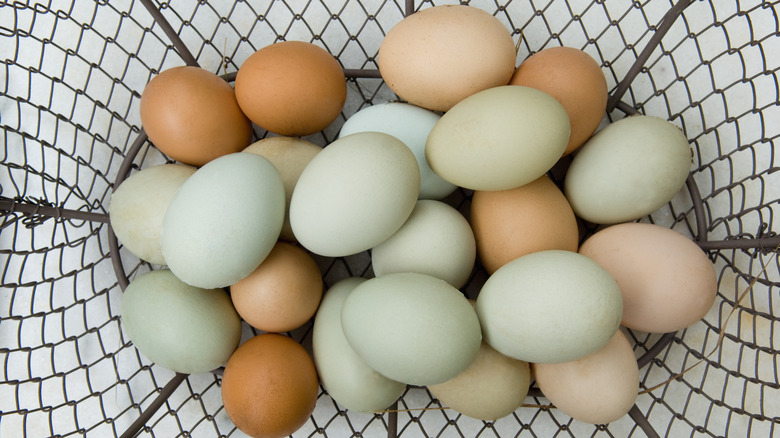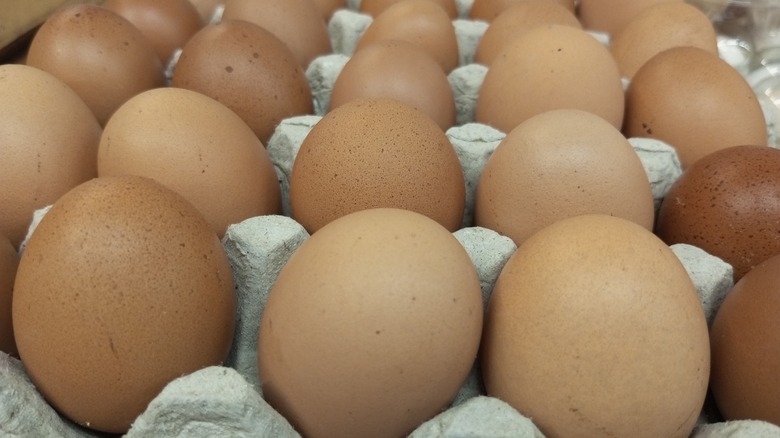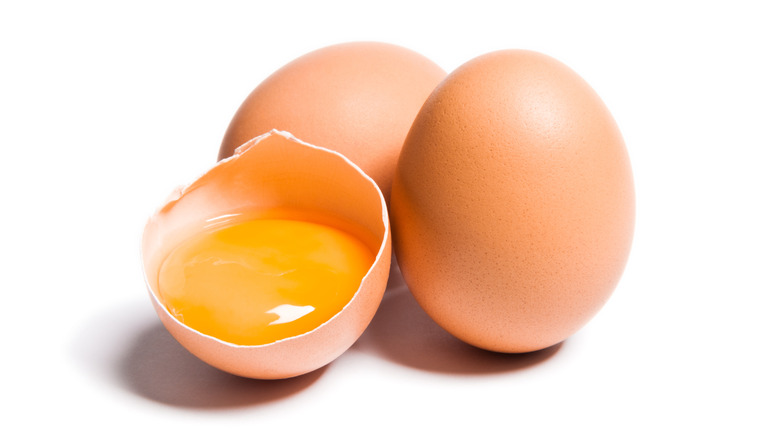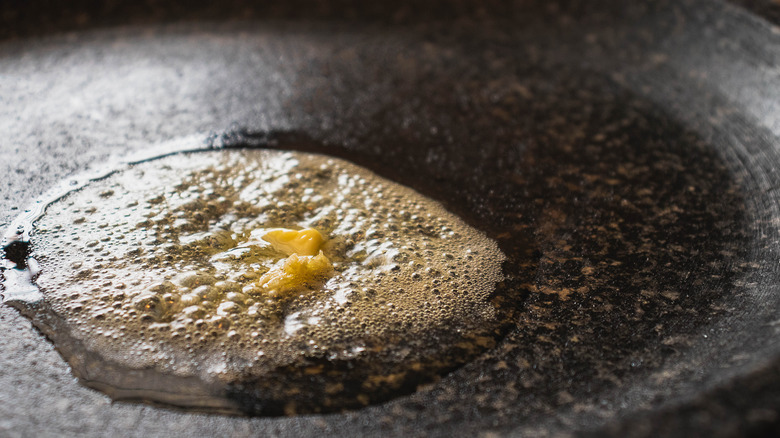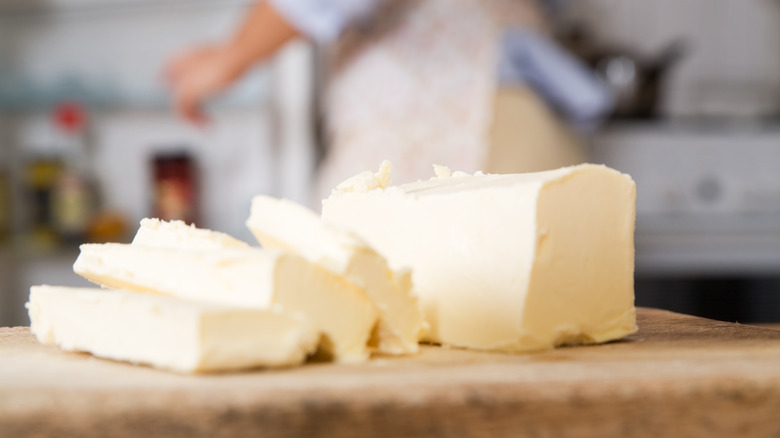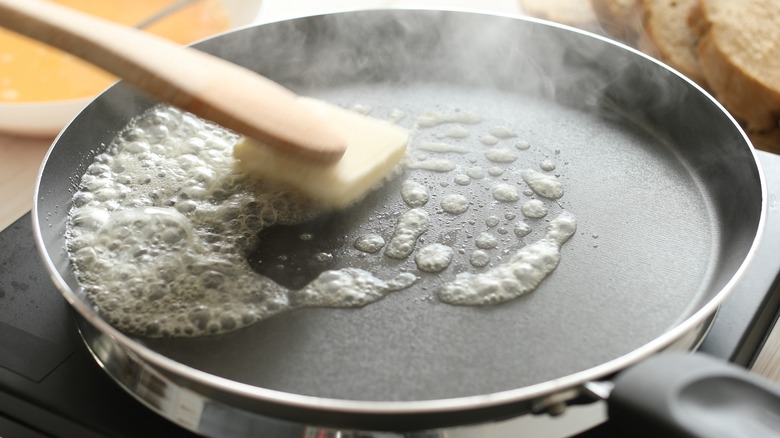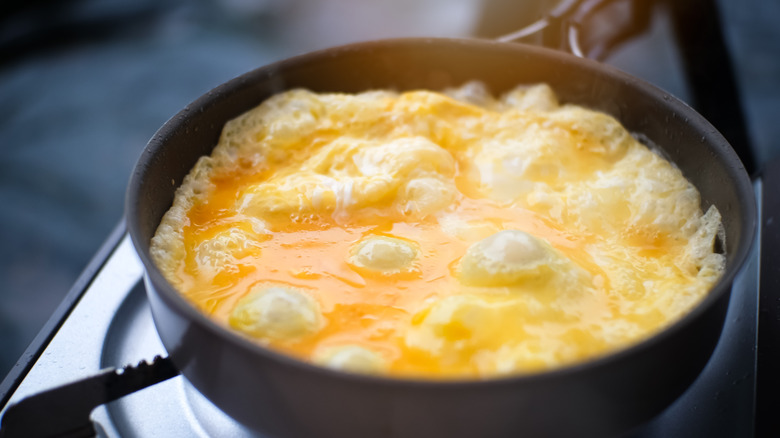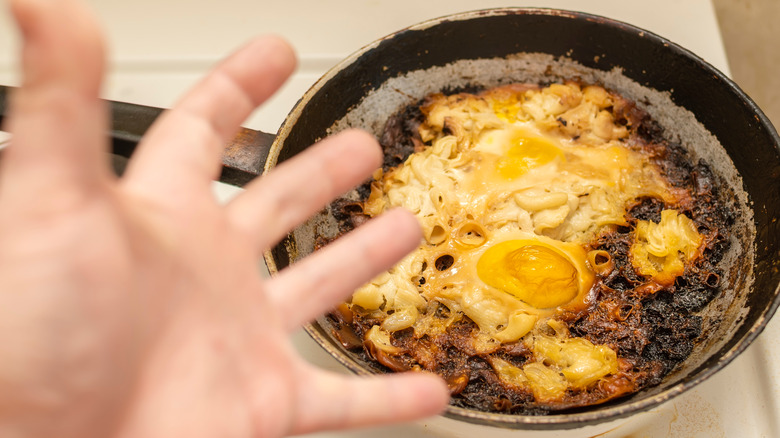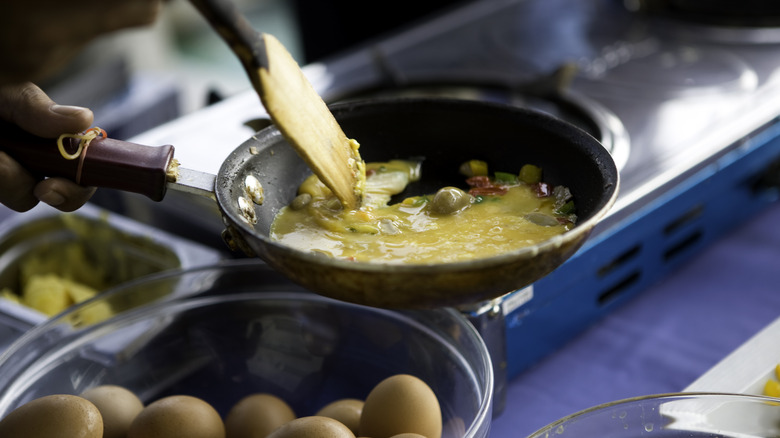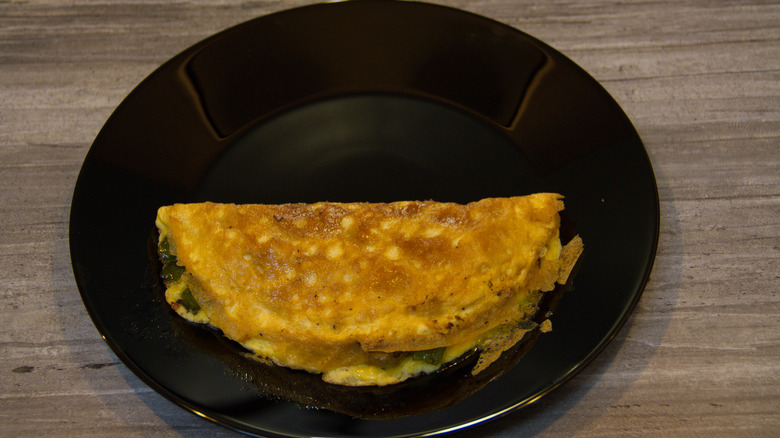Common Omelet Mistakes You Don't Want To Make
All you need to make a good omelet are a few eggs, oil, and butter. However, this beloved breakfast item is deceptively difficult to make. From the prep stage to the ingredients used to the cooking technique, there are several ways to screw up an omelet.
Using the wrong pan can leave you with more eggs stuck on your cookware than you have on your plate while using the wrong ingredients can compromise the integrity and flavor of your eggs. Not to mention the small window of time that separates an overcooked omelet from a perfect one.
The ideal omelet is fluffy, moist, and pale yellow in color. It should be soft in the middle and spring back when touched. If you've ever made an omelet that was tough or runny, you might be wondering what you're doing wrong. When it comes to this popular dish, knowing what not to do is half the battle. Save yourself some headaches by avoiding these common omelet mistakes.
Using the wrong pan
Let's say you just rolled out of bed on a Sunday morning with a hankering for an omelet. You might reflexively reach for your trusty stainless steel frying pan that you use for everything from gravy to sautéed vegetables. This would be your first mistake. Set yourself up for omelet success by choosing the right cookware.
Legendary French chef Jacques Pépin recommends an 8-inch nonstick pan for a 3-egg omelet. The nonstick part is essential if you want to avoid your eggs sticking to the bottom of the pan. An omelet should lift out of your cookware with ease, leaving no crusty residue behind.
Size also matters when it comes to choosing your omelet pan. If you go too big, the eggs will have a wider surface area to cover, leaving them thin and prone to breakage. You also don't want the pan to be too hot when you add your eggs as this will result in a brown, overcooked omelet. Heat the pan on medium-low heat until the butter melts and moves around easily without smoking or turning brown.
Your timing isn't right
When it comes to omelets, timing is everything. Beating your eggs for too long makes for a tough omelet while not beating them vigorously enough results in a lumpy one. The late great Anthony Bourdain noted in his 2016 book, "Appetites: A Cookbook," that you'll know you're done whisking — which, by the way, should be done with a fork and not a whisk — when the eggs are uniformly yellow with no strips of white. Beyond that, he cautioned, don't overdo it.
Once you've poured the eggs into the pan, immediately start moving them around in a circular pattern using either a fork or a spatula. This ensures that the omelet is cooked consistently throughout. Many people make the mistake of letting the eggs sit untouched for too long, which leads to browning.
An omelet is done when the center is still slightly runny. While this may seem counterintuitive, your omelet will wind up dry if you cook it for too long. The center will continue to cook after you remove it from the heat and fold it, resulting in the perfect moist consistency.
Overdoing it with added ingredients
While it's tempting to use omelets as an opportunity to clear out your vegetable drawer, less is often more. Adding too many veggies causes eggs to break, leaving you with more of a scrambled egg consistency than an omelet.
If you are going to add produce — bell peppers, onions, tomatoes, and mushrooms are popular omelet additions — stick to small quantities (no more than ½ cup of each veggie) so you don't end up with more veggie than egg. You'll also want to make sure that any additions are thoroughly cooked. Vegetables release water during the cooking process, which means if you cook them along with your eggs, you'll have a soggy omelet on your hands.
Some people like to add milk or cream to their omelets, but milk tends to dilute the eggs' flavor and make for a rubbery texture. If you want your omelet light and fluffy, skip the dairy altogether.
Using too many eggs
If you're the type who likes to make breakfast for loved ones, resist the urge to make more than one omelet at a time. You might be thinking you can make a bigger portion by simply adding more eggs and using a larger skillet, but that'll only leave you with an unevenly cooked creation that's difficult to roll properly.
Two to three eggs is the sweet spot for an omelet. Any more than that, and it becomes challenging to move the eggs around the pan properly, and therefore difficult to cook them to perfection. No one wants an omelet that's broken, unevenly cooked, or excessively eggy tasting. Your breakfast guests can wait a little longer for you to whip up each omelet individually. Quality over quantity is the key here.
If you really want to make an omelet-like dish that serves more people, try a frittata instead. Not only can you add more eggs, but you can also get a little more creative with the toppings.
Using eggs that aren't fresh
You're ready to get cracking (pun intended) on your omelet, so you root around in your fridge and find half a carton of eggs. But when you bought them, you can't recall. According to the United States Department of Agriculture, eggs are safe to consume for three to five weeks after being placed in the refrigerator, as long as you bought them before the sell-by date. However, just because eggs are technically safe for consumption doesn't mean they're the best candidates for your omelet. Unsurprisingly, the fresher the eggs, the fresher your omelet will taste.
As eggs age, the yolk absorbs moisture from the white. This moisture evaporates through the egg's pores, which allows more air to penetrate the shell, according to the USDA. With this extra air inside the shell, the egg covers a wider surface area once it's cracked open. What does this mean for your omelet? It will be thinner and more easily broken. If you don't want to compromise your omelet's structural integrity or flavor, seek out farm-fresh eggs. Maybe save those old eggs for a cake instead.
Prepping the eggs wrong
You're not alone if you've been cracking eggs on the side of a bowl your entire life. However, if you're sick of eggshell fragments finding their way into your recipes, there's a better way. Simply give the egg a single, firm rap against the flat surface of a countertop. Not only does it create a cleaner break, but if any pieces of shell do splinter off, they'll end up on your counter rather than in the bowl with your egg.
Once you've cracked your eggs, it's time to beat them. Timing is everything during this step. Beating your eggs for too long makes for a tough omelet while not beating them vigorously enough results in a lumpy one. You'll know you're done whisking — which, by the way, should be done with a fork and not a whisk — when the eggs are uniformly yellow with no strips of white. Beyond that, don't overdo it. Finally, season your eggs with salt and fresh cracked pepper to subtly enhance the flavor of your omelet.
Not greasing the pan properly
Despite its name, a nonstick pan still needs to be properly greased before you start cooking. Not only does this preserve the coating of your pan, but it also allows the omelet to slide right out of the skillet intact. The best way to grease a nonstick pan is with a small amount of butter before you turn on the heat. You don't need much; one tablespoon should do the trick.
Once you've turned the heat on, swirl the butter around the pan as it melts to coat the skillet evenly. If you don't properly grease your pan, parts of your omelet may stick to the skillet, resulting in breakage which in turn makes flipping more difficult. A shimmering layer of butter on the pan improves the omelet's flavor and allows for a more even cook.
If you're thinking of using cooking spray instead of butter, think again. Your omelet won't taste as good, and it's damaging to nonstick cookware. Cooking sprays leave behind a sticky residue that's difficult to wash off. That residue builds up over time, making it easier for food to stick to the pan.
Using the wrong butter
If you're chasing omelet perfection, the kind of butter you use matters. Clarified butter, or ghee, works best because it has a higher smoke point and therefore won't brown as easily as salted or unsalted butter. If you don't have clarified butter on hand, use unsalted butter rather than salted. This gives you full control over the flavor of your omelet.
In addition to greasing your pan with butter, adding extra to the eggs themselves makes for a better-textured omelet. That's because the protein molecules in eggs start moving around when heat is applied, forming new chemical bonds in the process. When too many of these bonds form, you end up with dense, rubbery eggs. Added butter can help, as it coats the proteins with fat, preventing them from forming bonds. Your best bet is to use cubed, frozen butter to ensure that it disperses evenly through the eggs and doesn't melt too fast.
Your pan is too hot (or not hot enough)
You want to give your pan a chance to heat up a bit before adding in the eggs. If the pan isn't hot enough, you'll need to cook the eggs longer, which pulls out moisture and makes it harder to achieve a consistent cook throughout. (Hello, burnt edges!) On the flip side, you don't want your pan too hot either. That's a recipe for browning, burning, and dryness. For best results, allow the butter to heat up for a minute or two before you add the eggs. Medium heat is your friend here; resist the urge to crank up the temperature to speed up the cooking process. If your butter starts smoking or turning brown, the pan is too hot.
A great way to know when your skillet has reached an optimal temperature is to use the water droplet test. Simply flick a few droplets of water onto the pan. If the droplets sit on the pan and take their sweet time evaporating with no accompanying hissing sound, the pan isn't hot enough. If the droplets immediately evaporate with a loud hiss, the skillet is a bit too hot. You've got a Goldilocks pan on your hands (juuust right) when the water droplets sizzle into small bubbles that evaporate quickly.
Not keeping it moving
When your pan is properly greased and warmed up, it's time for the omelet making to begin in earnest. Here's where technique really comes into play. You don't want to haphazardly push the eggs around the skillet or walk away for a minute to wash some dishes. Now is not the time for a bathroom break. Once the eggs are in the pan, you've got to keep them moving.
Using a spatula, stir the eggs around in a figure-eight pattern, periodically scraping the sides of the pan so the edges don't overcook. As you stir, use your other hand to rotate and tilt the pan to move cooked bits of egg back toward the center. This takes some coordination — and some practice — but it makes for a uniformly cooked omelet. It also allows the eggs to coagualate in a manner that makes the omelet easy to flip out of the pan.
Overcooking your eggs
Over medium heat, the omelet cooking process doesn't take long. Julia Child whipped one up in less than 20 seconds during an episode of "The French Chef" while other experts claim it should take no more than a minute or two. If you're waiting for your omelet's center to cook thoroughly before you take it off the heat, you're going to have a tough-textured, bitter-tasting breakfast.
An omelet is done when the center is still slightly runny. While this may seem counterintuitive, remember that the eggs will continue to cook after you remove them from the heat and fold them. It's better to err on the side of caution and allow the eggs to finish cooking off heat than to wait too long and burn your omelet or dry it out. If you've had experiences where your omelet seemed to cook too fast and you couldn't avoid browning or burning, turn down the heat next time.
Failing to let it set
You've been focused and in the zone stirring those eggs around the pan. Now it's time to take a quick breather before you flip and plate your omelet. Take your pan off the heat and allow the eggs to sit untouched for about a minute. This ensures that the bottom layer is evenly cooked, which will make flipping the omelet easier. Your finished product will look better and you won't have any undercooked, runny bits. Without this step, your eggs may be too liquidy and fragile, making a clean flip nearly impossible.
Allowing your omelet to set off heat is also a great hack to avoid overcooking. This way, your edges won't burn as you wait for the center to cook through. How do you know when an omelet is done setting? It should look moist but not too runny and not jiggle too much when you move the pan.
Adding the cheese at the wrong time
Who doesn't want ooey-gooey cheese in their omelet? Perhaps the most common omelet addition, cheese adds a little bit of character to an otherwise simple dish. However, it's essential to add it at the right stage of the cooking process.
You don't want to sprinkle cheese in with your eggs during the prep stage or dump it into the skillet right when you start stirring. Hervé Malivert, the director of Culinary Affairs at the Institue of Culinary Education told HuffPost in 2023 that it's best to add cheese when the eggs are 85% cooked.
If you add cheese too early, the eggs will take longer to cook, which often results in the underside overcooking while the top layer is still runny. Waiting until the omelet is setting off heat allows for perfectly melted cheese and doesn't compromise the eggs' texture. As for the type of cheese, you want something that melts well.
Your flip game is off
The flip is perhaps the most intimidating part of making an omelet. Nobody wants to be the person scraping eggs out of the pan or staring bewildered at what looks more like an egg pancake than an omelet. Julia Child made omelet flipping look easy on "The French Chef," demonstrating how to jerk the pan in such a way that the eggs moved toward the lip of the skillet, flipping over in the process. With the eggs in a half-moon shape, she then turned the pan upside down over a plate, creating a perfectly formed omelet.
If you've tried and failed to master this technique numerous times, there's an alternate method that yields the same result. America's Test Kitchen recommends sliding the omelet onto a plate when it is still fully flat and then using a paper towel to roll the omelet by hand. It looks just as professional but requires less precision and wrist control.
